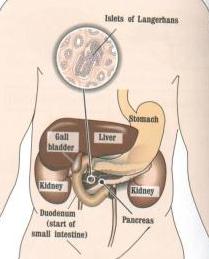 (HealthDay News) -- Changes in blood glucose levels may help prevent the onset of type 2 diabetes, Japanese researchers report.
(HealthDay News) -- Changes in blood glucose levels may help prevent the onset of type 2 diabetes, Japanese researchers report.Type 2 diabetes often occurs because a person's cells no longer respond to the hormone insulin, which is crucial for lowering blood glucose (sugar) levels.
Before a person becomes diabetic, his or her body tries to compensate for the increasing resistance to insulin by upping the amount of insulin secreted and the mass of insulin-secreting cells (beta cells) in the pancreas.
Increasing beta cell mass can potentially be a treatment for type 2 diabetes, experts say. But exactly what triggers an increase in beta cell mass in people who eat a high-fat diet has been unclear.
In a study involving diabetic mice fed high-fat diets, researchers at the University of Tokyo reported that changes in glucose concentration were probably the major trigger for increased beta cell mass.
Reporting in the January issue of the Journal of Clinical Investigation, the team focused on mice with only one copy of a gene called GCK, which produces a kind of molecular sensor that gauges blood glucose levels. These mice showed little increase in beta cell mass, compared with normal mice.
A molecule known as insulin receptor substrate 2 (IRS2) was shown to be an important mediator of the beta cell mass increase after GCK first sensed increased blood glucose levels, the researchers said.
Future studies are needed to determine the mechanism linking GCK and IRS2. The researchers hope that this will lead to new strategies of increasing beta cell mass as a treatment for type 2 diabetes.
More information
The American Diabetes Association has more about diabetes.


No comments:
Post a Comment